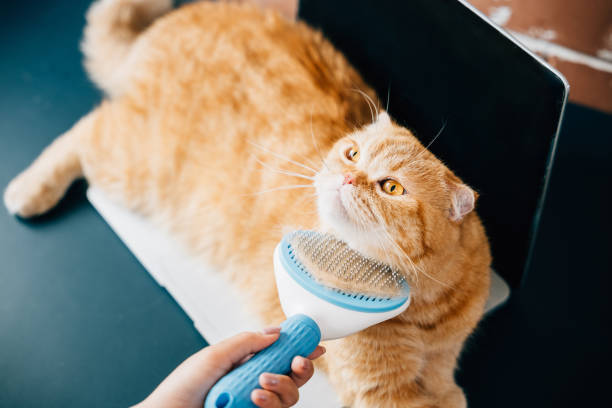
Finding the Best Cat Brush for Undercoat: Keep Your Cat’s Coat Healthy and Tangle-Free
Share
If you’ve ever noticed your cat shedding fur all over the house or developing painful knots, you’re not alone. Cats, especially long-haired breeds, shed heavily and develop dense undercoats that require regular maintenance. That’s why investing in the right cat brush for undercoat is one of the best things you can do for your feline friend’s comfort, health, and appearance.
At Total Pet Supplies, we know that grooming isn’t just about keeping your cat looking cute — it’s essential for their wellbeing. In this guide, we’ll walk you through why undercoat brushing matters, the best brush types for different cats, and how to brush like a pro without stress (for you or your cat!).
Why Brushing Your Cat’s Undercoat Is So Important
Cats naturally groom themselves, but even the most meticulous kitty can’t fully manage an undercoat on their own. The undercoat is the dense, soft layer beneath the topcoat that helps with insulation and temperature regulation.
Without proper brushing, this undercoat can:
-
Mat and tangle, especially in long-haired breeds.
-
Trap dirt and dander, leading to itchy skin and irritation.
-
Cause excessive shedding, which means more hair on your couch and clothes.
-
Lead to hairballs, as your cat ingests loose hair during self-grooming.
By using the best cat brush for undercoat maintenance, you’ll help remove dead fur, stimulate natural oil production, and reduce shedding — all while keeping your cat’s skin healthy and coat shiny.
What Makes a Good Cat Brush for Undercoat?
Not all brushes are created equal. Choosing the wrong one can tug at your cat’s fur, irritate their skin, or simply not reach the thick underlayer effectively. When selecting a cat brush for undercoat, look for these key features:
1. Fine, Closely Spaced Bristles or Teeth
Brushes with fine metal teeth are ideal for reaching through the topcoat to the undercoat without scratching the skin. This helps remove dead fur efficiently.
2. Gentle, Rounded Tips
Rounded or coated tips protect your cat’s delicate skin from scratches, especially if you’re brushing sensitive areas like the belly or behind the ears.
3. Ergonomic Handle
Grooming sessions can take time. A comfortable grip will make the experience easier on your hands and help you stay consistent with grooming.
4. Easy-Clean Design
Look for self-cleaning cat brushes or those with a quick-release button. It saves time and keeps the brush hygienic.
5. Suitable for Your Cat’s Coat Type
A long-haired Maine Coon and a short-haired domestic cat have very different grooming needs. Always check the product description or consult your groomer to find the right match.
Types of Cat Brushes for Undercoat
There’s no one-size-fits-all approach when it comes to grooming. Let’s explore the most popular types of cat brushes for undercoat care and which cats they suit best.
Slicker Brush
A slicker brush is one of the most common tools used for detangling mats and removing loose undercoat fur. Its fine, curved wires reach through thick fur layers, making it perfect for medium- to long-haired cats.
Best for: Persians, Ragdolls, Norwegian Forest Cats, and Maine Coons.
Deshedding Tool
A deshedding brush, often with stainless steel edges, is designed specifically to reach deep into the undercoat and remove loose fur before it sheds around your home.
Best for: Cats that shed heavily, like Siamese, Burmese, and domestic short-hairs.
Grooming Comb
Combs work wonders for finishing touches and for cats who dislike brushes. Use a wide-tooth comb for detangling and a fine-tooth comb for smoothing.
Best for: All coat types, especially for cats that are brush-shy.
Undercoat Rake
This type of brush is built to glide through thick double coats, pulling out undercoat hair gently but effectively.
Best for: Long-haired and double-coated breeds.
Rubber Grooming Brush
Rubber brushes are fantastic for massaging and removing surface fur. They also promote blood circulation, which keeps your cat’s skin healthy.
Best for: Short-haired cats or those sensitive to metal brushes.
How to Brush Your Cat’s Undercoat Like a Pro
Even the best cat brush for undercoat won’t help if you don’t use it properly. Follow these simple steps to make grooming a calm, effective routine:
Step 1: Create a Calm Environment
Cats pick up on your energy. Choose a quiet space and let your cat sniff the brush before starting. Reward calm behaviour with treats.
Step 2: Start with Short Sessions
If your cat isn’t used to brushing, begin with a few minutes and gradually increase as they grow comfortable.
Step 3: Brush in the Direction of Hair Growth
Always follow the natural direction of your cat’s fur to avoid pulling or causing pain.
Step 4: Focus on Problem Areas
Pay attention to the neck, chest, and hindquarters — these are hotspots for matting.
Step 5: Finish with Praise or Playtime
Positive reinforcement helps your cat associate brushing with rewards, making future sessions easier.
Grooming Tips for Cats with Thick Undercoats
If your cat has a particularly thick or long coat, here are a few pro tips to make the process smoother:
-
Brush at least twice a week during shedding seasons (spring and autumn).
-
Use a detangling spray if the fur is prone to matting.
-
Never cut out mats — instead, use a dematting comb or seek professional grooming help.
-
Keep your brush clean to prevent bacteria or oils from transferring back into your cat’s fur.
-
Check for skin conditions regularly — flaky skin, redness, or bald patches could indicate allergies or parasites.
Signs You’re Not Brushing Often Enough
It’s easy to tell when your cat’s grooming routine needs improvement. Look out for these warning signs:
-
Clumps or mats forming in the fur.
-
Increased shedding around the house.
-
Dull or greasy coat.
-
Excessive licking or hairballs.
-
Irritated skin or scratching.
A consistent routine with the right cat brush for undercoat maintenance can prevent all of these issues — saving you time, cleaning, and vet visits.
Benefits of Regular Undercoat Brushing
Brushing isn’t just for aesthetics — it’s an important health habit. Here’s what you and your cat gain from regular undercoat care:
-
Less shedding around your home.
-
Healthier skin and coat thanks to improved air circulation and oil distribution.
-
Reduced hairballs and digestive issues.
-
Stronger bond between you and your pet through grooming time.
-
Early detection of fleas, bumps, or skin conditions.
It’s a simple five-minute ritual that can prevent hours of stress later on.
Choosing a Cat Brush for Undercoat from Total Pet Supplies
At Total Pet Supplies, we stock a range of grooming tools designed for Australian pet owners who want both quality and comfort.
When you shop with us, you can find:
-
Self-cleaning undercoat brushes for quick fur removal.
-
Ergonomic handles to reduce wrist strain.
-
Gentle bristles designed for sensitive skin.
-
Affordable grooming kits with combs, slickers, and rakes for every coat type.
We only carry vet-approved grooming products that are safe, durable, and proven to work — because your cat deserves the best care at home.
Frequently Asked Questions
How often should I brush my cat’s undercoat?
For long-haired or double-coated cats, aim for 2–3 times a week, and daily during shedding season. Short-haired cats can be brushed once a week.
Can I use a dog brush for my cat?
No — dog brushes are usually too harsh or large for cats. Always use a brush designed specifically for cats.
My cat hates brushing — what should I do?
Start slow, reward calm behaviour, and use a soft rubber brush to begin with. Over time, your cat will learn to associate brushing with comfort.
What’s the best brush for a long-haired cat?
An undercoat rake or slicker brush works best, as they reach deep into dense fur without pulling.
Final Thoughts
Grooming isn’t just a beauty routine — it’s an act of care that improves your cat’s health and happiness. Choosing the right cat brush for undercoat makes all the difference. Whether you’re dealing with a fluff monster or a sleek short-hair, the right brush keeps your cat comfortable, your home cleaner, and your bond stronger.
Explore our range of cat grooming tools today at Total Pet Supplies — where caring for your pet’s coat is simple, stress-free, and affordable.
